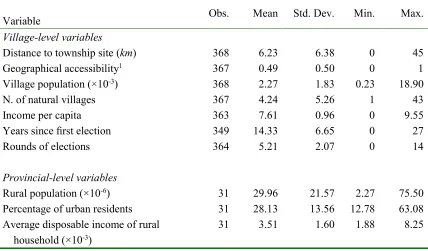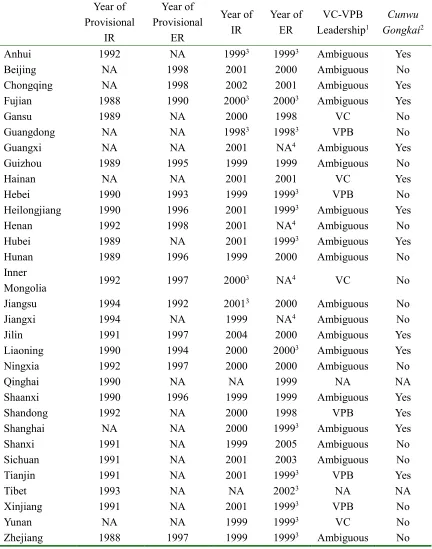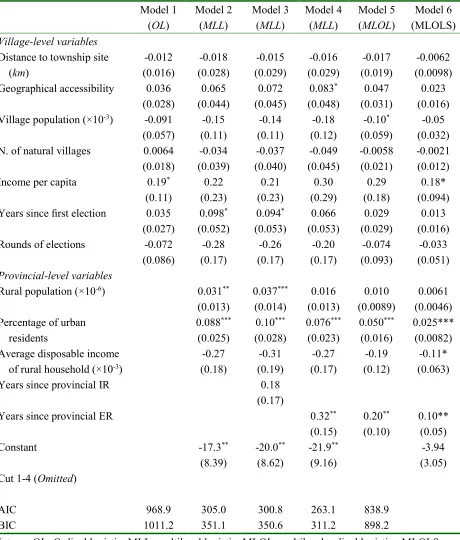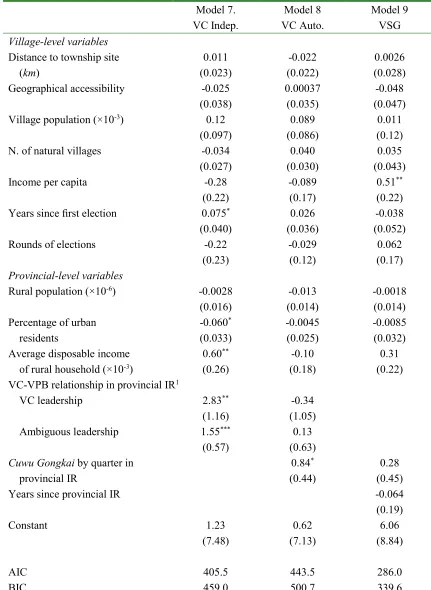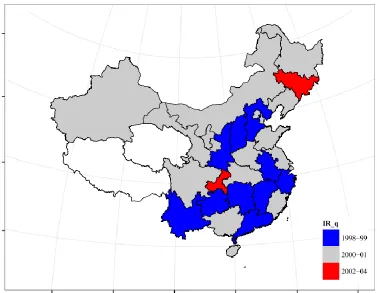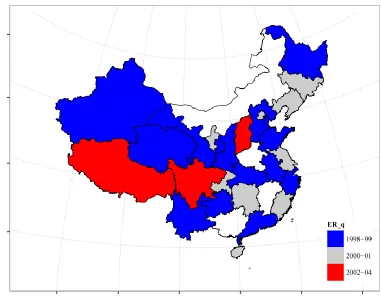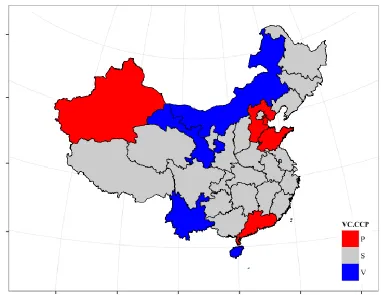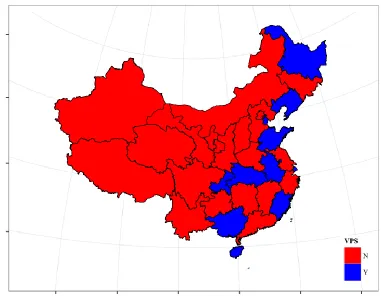Institutionalizing from the Middle:
Abstract
Nominal democratic institutions under non-democratic regimes vary across countries. This study intends to advance our understanding of such nominal democratic institutions by exploring the role of one aspect of the regime, government hierarchy. Focusing on the village-level
democratization in China, we stress the intermediary role of the provincial-level governments in shaping the variant outcomes of grassroots democracy across the country. Through an analysis of a national sample, we find that divergent provincial legislative interpretation of central
policies is a key determinant of the access to power and democratic governance of village-level governments. Our finding suggests that authoritarian states can employ various institutions to gather more accurate information, accommodate local variations, contain potential
intra-government disagreement and thus maintain regime stability.
Institutionalizing from the Middle: Understanding Provincial Legislation and Grassroots
Democracy in China
Recently, increasing scholarly interest has been devoted to nominally democratic institutions in authoritarian regimes (Boix and Svolik 2013; Magaloni 2010; Malesky and Schuler 2010; Wright 2008). Rather than treating elections and legislatures as mere window-dressing, this “institutional turn” in the studies of authoritarianism proposes that nominal democratic institutions are important to the survival and stability of authoritarian regimes. Yet a major challenge in comparative studies of such institutions is that they vary tremendously across authoritarian polities (Gandhi and Lust-Okar 2009). Any cross-national generalizations thus tend to leave the specific micro-logics of these democratic institutions less wel1-articulated (Malesky and Schuler 2010). This is particularly true in China, where a large number of nominal democratic institutions are in place, but their political effects remain understudied.
Unlike many other authoritarian regimes, the Chinese Communist Party (CCP) has only introduced competitive elections at the village level. Over the last two decades, both well-designed case studies and survey research (mostly based upon locally representative samples) have been devoted to assessing the quality and development of rural democracy.
In this study, we believe that one way to advance scholarly understanding about grassroots democratization in China is to examine the relationship between grassroots democratization and the regime hierarchy. In particular, we highlight the intermediary role of provincial-level governments in China’s party-state. This intermediary role renders provincial governments pivotal in formalizing and thus conditioning how rural democracy is implemented. Divergent provincial legislative interpretations of central policies provide the regime with an institutional channel to gather more accurate information, accommodate local variation, and limit potential intra-government disputes. Therefore, legislations at the provincial level strongly shape the variant outcomes of village democratization at the grassroots level.
Using a national sample of provincial legislation and village democracy (for details, see the Appendix A), this study reveals a considerable variation in efforts and in ways by provincial governments to institutionalize village democracy. To assess the influences of such aggregate provincial-level institutional factors, we employ a multilevel (i.e., village level and province level) hierarchical model that includes both provincial and village level factors and controls for the effect of unspecified provincial level factors. We consistently find that variations in the provincial contexts, particularly variations in the formal legislation, strongly shape the institutionalization of village democracy at the grassroots level.
arrangements help accommodate local variations. Second, we advance studies of village democratization in China by highlighting how varying provincial contexts intersect with village characteristics to condition the institutionalization of grassroots democracy. We thus provide a useful perspective to understand why villages across rural China demonstrate seemingly
inconsistent and idiosyncratic patterns of democratization. Together, our findings suggest that authoritarian regimes may employ a complex of institutions to solve the dual dilemmas of maintaining popular support and contain internal disagreement. A comprehensive understanding of the resilience of authoritarian regimes therefore requires a thorough investigation of the micro-logics of these institutional complexities.
The next section briefly reviews the legislative role of provincial governments in
implementing grassroots democracy. We then examine the variations in provincial legislation on grassroots democracy. In order to examine the impacts of provincial legislation on village democracy, we operationalize both electoral institutions and governing institutions and evaluate the effects of various village- and provincial-level correlates by using multilevel hierarchical models. Finally, we conclude with a discussion of the theoretical and political implications of our findings.
I. Grassroots Democracy in Rural China: Inducing Mass Support
party secretaries who held a monopoly over critical collective resources (e.g., land). Since the onset of the post-Mao reforms, however, this mode of rural governance has become increasingly unsustainable. After decollectivization of agricultural production and abolition of the commune system, party secretaries lost their direct control over collective properties, and, as a consequence, their role in governing village affairs was seriously undermined. Meanwhile, economically empowered villagers became increasingly resistant to malfeasances by local cadres and
unpopular state policies (e.g., compulsory grain procurements, taxes and fees, and birth control policies). In a word, the post-Mao reforms not only unleashed rapid economic development but also created an unexpected dilemma for the CCP regime in terms of winning and maintaining support from the empowered peasants.
In recognition of this problem, the central government has introduced a new set of
institutional arrangements in rural China to adapt the grassroots governmental system to the new socio-political changes. The new grassroots rural system is anchored in the Village Committee (VC). According to the Organic Law of Village Committees (OLVC) promulgated by the
central government in 1987, the VCs are mass organizations of self-government at the rural level. Elected by the villagers, officials on the VCs are responsible for administering rural
government’s efforts to grant more autonomy to the VCs as a solution to the deterioration in Chinese rural governance.
Ever since its introduction, grassroots democracy in rural China has attracted considerable attention. Despite agreement on the critical importance of grassroots democracy to our understanding of the resilience of the CCP regime, scholars have not reached a consensus as to whether such grassroots democracy encourages democratization or consolidates CCP
authoritarian rule (Alpermann 2009; Kennedy 2002; Manion 2009; O’Brien and Han 2009; Zhong and Chen 2002). The large amount of evidence accumulated from earlier studies provides mainly inconsistent, if not contradictory, information about the overall status and patterns of village democratization.
As argued by Manion (2009), the problem in part has a lot to do with the substantial regional variations throughout the country. Although studies focusing on factors at the village level help explain grassroots sources of village democratization in China, they fall short in revealing the impact of the subnational contexts in which the grassroots democracy evolves. Thus in this study, we aim to explore the institutional sources of variations in China’s grassroots
democratization.
II. Divergent Patterns of Institutionalization of Village Democracy: Accommodating Local
Under the seemingly uniform framework of the national OLVC, how can we explain the considerable variations in the development of village democracy across rural China? Are such variations solely a function of village-level factors? Or do they also reflect certain fundamental characteristics of the institutional arrangements in the CCP regime? We argue that the
central-provincial arrangements in the CCP regime significantly condition implementation of important policies, such as village democracy. Though usually perceived from a holistic perspective, the regime is generally divided over major policies. Rather than resolving the disagreements forcefully in the national deliberative or decision-making bodies, more often than not the CCP regime leaves some thorny issues to the provincial governments and allows for divergent provincial interpretations and implementations of national policies. This downward transfer of power and authority not only renders implementation of national policies subject to the will and interests of both the national and the provincial governments. It also helps the regime to monitor popular preferences, address the local variations like levels of socioeconomic development and thus reconcile potentially conflicting priorities within various segments in such a large-size countries as China (Chung, 1995; Huang 1996; Montinola, Qian and Weingast 1995; Naughton and Yang 2004; Remick 2002; Solnick 1996). In light of this, this downward
delegation provides the regime an alternative channel to gather information through local variations in policy implementation and innovation (Manion 2015).
democratization. In light of this, institutionalization of village democracy does not mean that the national OLVC is carried out automatically or uniformly across the various regions. Rather, the OLVC introduces a new dimension of center-local dynamics that leads to variations in
grassroots democratization.
One way to explore the influence of the provincial institutional context, we argue, is to examine provincial legislation. In a departure from the Mao era, the “reform Constitution” (i.e., the 1982 Constitution) endowed the provincial people’s congresses (PPCs) with legislative power that previously had been under the control of the National People’s Congress (NPC) (Art. 100, 1982). This new center-province balance of power reflected the Center’s broader attempt to promote and formalize “both control and flexibility, and both national unity and local
efficiency” (Chung 2011; Lin 1992). Since then, PPCs have been granted power to enact detailed regulations regarding implementation of national laws as well as to initiate their own provincial legislation. In both cases, provincial legislation can create a relatively separate and stable subnational institutional environment within the provincial jurisdiction (Cho 2006; Lin 1992; O’Brien 2009; Wang 2014).
How, then, was village democracy formalized by the national and provincial governments in China? At the national level, political elites in the CCP regime were divided as to whether and to what extent village democracy should be implemented. This is because there was only limited available information about popular preferences and such local variations as
was “an example of ‘bourgeois liberalization’” that would endanger the party’s ability to rule (Li and O’Brien 1999: 132). Given the intra-party disagreements, the national OLVC adopted ambiguous language and explicitly delegated to the PPCs authorities to make specific
stipulations on critical issues, for instance, on the relationship between the VC and the village party branch (VPB) (Alpermann 2009; Guo and Bernstein 2004; Li 1999):
The standing committees of the people’s congresses of provinces, autonomous regions and municipalities directly under the Central Government may, in accordance with this Law and in light of the conditions in their own administrative regions,
formulate measures for the implementation of this Law. (Italics added by the author; see Art. 29 of the OLVC.)
Therefore, provincial-level governments are formally charged with responsibility to adopt rules and procedures regarding village democracy and are provided with ample space to interpret the OLVC and to promote their own initiatives. The pivotal role of provincial governments thus allows various segments of the regime to affect the actual implementation of the OLVC. On the one hand, provincial legislation may be instrumental for different national agencies (Cho 2006; Chung 2011; Lin 1992).1 For instance, Shi (1999) found that the Ministry of Civil Affairs
(MoCA) often lobbies the PPCs to promote more reform initiatives. On the other hand, legislation at the provincial level introduces various provincial and local government agencies into the legislative contestation and coordination. In most cases, sluggish and vague provincial legislation best serves the interests of local governments since more detailed provincial
1 It is interesting to note that this strategy is also common in economic legislation (see Lin 1992;
legislation leaves less leeway for county and township governments to intervene and manipulate village affairs at their will (Zhao and Guo 2007). As a result, the institutionalization of the OLVC is a product of constant interactions between national and lower-level governments (O’Brien 1994; Shi 1999).
III. Provincial Legislation on Village Democracy
After the promulgation of both the provisional and the formal OLVC, the standing
committees of the PPCs across the country began to draft their own legal documents on village democracy, including various regulations (tiaoli), rules (banfa), and opinions (yijian). These documents are anchored in two key pieces of provincial legislation, electoral regulations (ERs), mainly with respect to the rules and procedures for VC elections, and implementation regulations (IRs), mainly with respect to post-electoral village governance. For this reason, we focus primarily on the ERs and the IRs to explore the variations in provincial legislation.
Rather than following the same styles and formats, IRs and ERs issued by the PPCs vary across provinces in important ways. In this study, we choose to examine the following three dimensions: the time of introduction of the provincial IRs and ERs, the authority relationship between the VC and the VPB, and the transparency of village management (cunwu gongkai). First, these three dimensions of provincial legislation are not only broadly comparable but they are also closely related to the VC elections and village governance at the grassroots level.
Third, the three areas encompass the differences between the IRs and the ERs in terms of both content and timing. Thus, they can provide a comprehensive picture of the provincial
legislation.
[Figure 1 is about here.]
[Figure 2 is about here.]
A. Time sequence of the Provincial IRs and ERs
As demonstrated in Fig. 1 and Fig. 2, there is considerable variation in terms of how soon different provincial governments introduce their own formal IRs and ERs through the PPCs. Take a provincial IR as an example: After final promulgation of the OLVC by the NPC on November 4, 1998, a mere twenty-three days later (on November 27, 1998) the Standing Committee of the Guangdong PPC passed its IRs. In contrast, it took over five years for the Jilin PPC to finalize its IRs (i.e., on March 1, 2004). Moreover, at the time of this research, neither Qinghai nor Tibet had yet enacted their own provincial IRs. Further examination of the provisional IRs, provisional ERs, and formal ERs also indicates wide variation in terms of the timing of their promulgation.
can help coordinate the conflicting organizational interests among the various government agencies (Cho 2006; Xia 2008). Prolonged legislative processes, therefore, indicate strong departmental and local opposition to implementation of the OLVC, which in turn has a negative impact on the development of rural democracy. Third, the earlier that provincial IRs and ERs are promulgated, the longer villagers are exposed to more detailed regulations on VC elections and the more experience they will have with democratic governance. In sum, provinces with earlier provincial IRs and ERs are in a better position to advance grassroots democracy.
B. The Authority Relationship between the VC and the VPB
A main obstacle to grassroots democratization in rural China is penetration of the party-state via the VPB (Alpermann 2001; Guo and Bernstein 2004; O'Brien and Han 2009; Oi and Rozelle 2000; Tan and Xin 2007). Ever since introduction of the VC elections, the exercise of VC power has been strongly influenced by the village party secretaries. As agents of the party-state, party secretaries are more responsive to upper-level governments than they are to the VCs. Therefore, the prominence of the VPB in village affairs can endanger village self-governance. While the early tugs-of-war between the VCs and the VPBs in village governance were usually played out informally, recent party penetration of the VCs has been increasingly institutionalized, particularly through concurrent office-holding (yijiantiao), that is, the party secretary also
As the guiding document on village self-governance, the 1998 OLVC remains quite
ambiguous in terms of the authority relationship between the VCs and the VPBs. While stating that the VPB is the village “leadership core,” the OLVC also insists that the VPB should “support the villagers and ensure that they carry out self-governance and exercise their democratic rights directly.” This dialectic statement, as discussed earlier, can be attributed to the disagreements among the national leadership with regard to how to balance the relationship between party control and grassroots democracy. As a result, provincial governments have reacted in differing ways, displaying an interesting “triple mix” pattern (Chung 2000).
[Figure 3 is about here.]
Anecdotal evidence indicates the strong impact of provincial regulations on VC-VPB
relations. In 2001, 57 elected VC chairs in Shandong, one of the “resistant” provinces, resigned en masse in protest against the VPB’s intervention in village affairs (Eckholm, 2002; Zhou, 2001). This unusual collective protest, though receiving some national attention (e.g., in the People’s Daily), did not make any breakthrough since senior officials referred to the provincial
legislation as the guideline to resolve VC–VPB disputes. In another resistant province, Guangdong, it has been found that concurrent office-holding has significantly undermined the role of the VC in village affairs (Zhao and Guo, 2007). Here we hypothesize that provincial legislation on the VC-VPB relationship is strongly correlated with the actual autonomy of the VC. Specifically, we expect that there are more party-dominant villages in the “resistant” provinces and less party-dominant villages in the “pioneering” provinces.
C. Transparent Village Management
Even if the VC is democratically elected and exercises power independently, “it does not necessarily follow that village government is democratic” (Chan 1998, 518; Alpermann 2001; O'Brien and Han 2009). The quality of village self-governance is also determined by how effectively village government is monitored and supervised by ordinary villagers. As a measure to institutionalize the villagers’ right to “democratic supervision,” transparent village
and thus advance village democracy.
[Figure 4 is about here.]
Since the OLVC is explicit about implementation of transparent village management, no provincial government has chosen to take a “resistant” position. However, the provinces have been divided as to whether to promote the institutionalization of democratic supervision a step further. As revealed in Fig. 4, even though sixteen provinces maintained the original
requirement stated in the 1998 OLVC, thirteen provinces decided to pioneer by mandating that the VC should publicize critical village issues at least four times a year rather than twice. Comparing Fig. 4 to Fig. 3, we do not see much overlap in the two dimensions of provincial legislation with regard to village governance. This indicates that a stipulation on party involvement or even party dominance does not necessarily correlate with less or greater willingness of the provincial governments to have more transparent village management.
Although there are few survey studies examining the relationship between provincial regulations and village management, some field studies indicate that provincial regulations and village management tend to bear a strong correlation (Yu 2008). We thus expect that there are more transparent villages in terms of finances in provinces that are more supportive of implementation of transparent village management.
Thus far, we have found that there are considerable variations in provincial legislation regarding the OLVC, and we expect that these differences will be correlated with different dimensions of grassroots democracy in rural China. Based on a 2006 nationwide survey sponsored by the MoCA (for more details, see the Appendix), this study empirically examines the impact of provincial legislation on village democratization. When assessing grassroots democracy in rural China, scholars are divided as to whether to focus on electoral institutions (i.e., “access to power”) or to examine actual implementation of village governance (i.e., the “exercise of power”) (Alpermann 2009; Lu 2012; Manion 2009; O'Brien and Han 2009). Here we do not assume that the two approaches are mutually exclusive, and thus we examine both the access-to-power and the exercise-of-power dimensions of village democratization.
A. Access to Power: Electoral Institutions
Although the 1998 OLVC provided very detailed instructions on how VC elections should be carried out, actual implementation varied considerably across the country (Lu 2012; Manion 2009). Localities varied in terms of organizing their village election committees, nominating candidates, finalizing formal candidates, and casting votes, thus defying an easy assessment of rural electoral institutions in China. We follow Lu’s (2012) strict approach to evaluate the quality of electoral institutions. Specifically, we examine whether a village fulfilled all four
[Table 1 is about here.]
As demonstrated in Table 1, our results are consistent with those of Lu (2012). Although candidates were nominated through the sanctioned procedures in a majority of villages (76 percent) and adopted multiple-candidate elections (91 percent), less than half (48 percent) did not violate the rules in organizing the election committees and only about one-third (37 percent) followed the 1998 OLVC in deciding upon the formal candidates. As a whole, less than one-sixth of the surveyed villages fulfilled all the requirements stipulated by the 1998 OLVC. To avoid our analyses being driven by the choice of a particular measurement, we used both a binary variable and a summary index to operationalize the village electoral institutions. The most obvious, important, and easily
measured index of progress in democratization is electoral competitiveness-the number of candidates on the ballot relative to the number of offices
Coded one if electoral data are available, zero otherwise.
bExcess candidates divided by number of positions (coded zero if data are unavailable)
B. Exercise of Power: The Governing Institutions
To gauge the quality of post-electoral governance, we focus on the following three dimensions: the independence of the personnel on the VC, the autonomy of the VC in
decision-making, and the existence of village supervision groups (VSGs). The relevance and importance of these three dimensions to village self-governance have been confirmed by prior studies on rural democratization in China. Moreover, these three dimensions are closely related to our identified variations in provincial legislation. Thus we believe that the three dimensions can provide a reliable test of the impacts of provincial legislation on village governance.
VC Independence. The independence of the VC, as discussed earlier, has been penetrated by
the party-state via a more institutionalized form, that is, concurrent office-holding (Guo and Bernstein 2004; O’Brien and Han 2009). Although fieldwork and local sample-based surveys suggest widespread overlapping of personnel, there have been no empirical studies based on a national sample to investigate this practice (Manion, 2009; O'Brien and Han 2009, 372). Our study gauged VC independence by examining when a village party secretary held any position (including that of chair, vice chair, or member) of the VC. As demonstrated in row 1 of Table 2, 234 out of the 362 surveyed villages (64.6 percent) did not have concurrent office-holders. Therefore, the results suggest that in contrast to popular impression, a majority of villages still maintain relatively independent VCs at the moment of the survey.
[Table 2 is about here.]
VC Autonomy. Even when it is independent from the VPB, the VC is not always the only
in a village is contingent upon its underlying economic structure (Guo and Bernstein 2004; O'Brien and Han 2009; Oi and Rozelle 2000). In many localities, the VPB still plays a key role in managing critical village affairs, for instance, financial issues. If this is the case, one
expected outcome would be less transparent village management since party secretaries appointed by upper-level party branches are less restrained by transparent village management regulations. In light of this, VC autonomy in deciding on important issues like financial matters may serve as an important indicator of village self-governance. Here we operationalized VC autonomy by examining whether the VC is the only body involved in managing village financial matters. The results are reported in row 2 of Table 2. In more than 40 percent of the surveyed villages, party secretaries still have a great deal of influence on the popularly elected VCs in terms of managing village affairs, thereby causing many scholars to worry about the resurgence of party control.
Village Supervision Group (VSG). In order to ensure implementation of transparent village
majority of villages (85 percent) had created a VSG, indicating villagers’ enthusiasm to participate in village governance.
V. Model and Analysis
In order to explore the impact of provincial legislation on rural democratization, we employ a multi-level hierarchical approach in our primary analyses. Specifically, we use a two-level (i.e., village-level and province-level) mixed-effects model with random effects clustered at the provincial level. Multilevel modeling is suitable for our analysis for two reasons. First, the causal relationship of our concern (i.e., provincial-level legislation and village-level democracy) is cross-level in nature, and our data is hierarchical in structure, with village-level data nested in provincial units. Second, while we are able to identify the primary causal factor (i.e., provincial legislation) and other factors of village democracy at the provincial level, there are many other potential factors that are not specified but associated with the differences across provinces. Including random effects at the aggregate level helps controlling for the effect of unobserved provincial level factors.
[Table 3 is about here.]
Table 3 presents the results of analyses of village electoral institutions. Model 1 and Model 2 do not include the provincial-level institutional variables that are of primary interest. A
strongly shape the development of electoral institutions in rural China. The difference between the two models also suggests that without taking into consideration the explanatory variables at both levels, our understanding of grassroots democracy will be incomplete, if not highly biased.
The results of Models 3, 4, 5, and 6 suggest that only the length of time since promulgation of the provincial ERs is strongly correlated with high-quality VC elections at the grassroots level, and the impact of the ERs is persistently significant regardless of the specific measurement of the village electoral institutions. This is because the 1998 OLVC provides relatively detailed stipulations on specific procedures for VC elections (Lu 2012; Tan 2004), leaving little room for adjustments by the provincial ERs. Therefore, the length of time since the year of promulgation, rather than the content of the ERs, is likely to serve as the main source of variation in village electoral institutions. However, because the OLVC is limited and vague about village governance, it is the variation in the content of the provincial IRs that is likely to affect the exercise of power in rural China.
In addition, a comparison of Models 2 and 4 reveals that once the number of years since enactment of the provincial ERs is added to the analysis, the significant impact of the number of years since the first VC election at the village level diminishes. This implies that with regard to the quality of village electoral institutions, village-level factors, even institutional factors, do not matter a lot in comparison to the provincial institutional context. Therefore, the national pattern of village electoral institutions is highly clustered, contingent upon the year of promulgation of the provincial ERs.
We present the effects of provincial institutions on village democratic governance in Table 4. For each of the three governance dimensions, we include in the model only the provincial
institutional variables that have a meaningful and direct relationship with that dimension. First, with respect to VC independence in its relation to the VPB (Model 7), a suggestion of VC
leadership in provincial legislation significantly increases the probability of strong VC
independence compared to the other two situations. And if provincial legislation does not spell out a definite relationship between the VC and the VPB, the VCs in that province on average enjoy greater independence than those where party leadership is clearly stated, but less than in those where VC leadership is formally promulgated. In sum, these findings suggest that the provincial government’s stance on the authority relationship between the VC and the VPB strongly shapes the overlapping of personnel between the two institutions at the grassroots level.
Finally, none of the provincial-level variables, including the institutional variables, has any significant effect on whether or not there is a VSG in the village (Model 9). For this dependent variable, only the level of economic development seems to make a difference. Given the high stakes held by village officials, peasants in the wealthier villages have stronger motivations to more closely monitor and supervise village financial affairs.
VI. Conclusions and Discussion
In this research, we are inspired by the basic understanding that while studying the political institutions of authoritarian states, we should not limit our attention to national institutions. The eventual political outcomes of institutions in authoritarian countries, as in democratic countries, are jointly shaped by the role of political elites and institutions at both the national and local levels. Specifically, when assessing and analyzing China’s rural democratization, we should take into consideration the role of intermediary governments in the Chinese state. The Chinese state is highly decentralized and fragmented. Provincial governments, as agents of the Center and the principals of lower-level governments, play a pivotal role in China’s bureaucratic chain by modifying various state policies through their discretionary legislation or policy
implementation and by taking new policy initiatives based on the situation and development of local affairs.
interactions between the Center and lower-level governments. “Local segments of the state apparatus,” as noted by Remick, “are not merely weaker or diluted versions of the central state on the periphery” (Remick 2002: 401). Instead, they tend to have their own institutional interests and varying kinds of relationships with their local societies. Therefore, when advancing the institutionalization of rural self-governance, villages across the country are embedded in different subnational contexts. This not only reaffirms the need for more systematic and comparative research (Manion, 2009), but also highlights the necessity of introducing a more integrated perspective on the development of village democracy.
References
Alpermann B. Institutionalizing Village Governance in China. J Contemp China. 2009;18(60):397-409.
Alpermann B. The Post-Election Administration of Chinese Villages. China J. 2001;46(Jul.):45-67.
Boix C, Svolik MW. The Foundations of Limited Authoritarian Government: Institutions, Commitment, and Power-Sharing in Dictatorships. J Polit. 2013;75(2):300-16.
Chan S. Research Notes on Villagers' Committee Election: Chinese-style Democracy. J Contemp China. 1998;7(19):507-21.
Cho YN. The Politics of Lawmaking in Chinese Local People's Congresses. China Q. 2006(187):592-609.
Chung JH. Central Control and Local Discretion in China: Leadership and Implementation during Post-Mao Decollectivization. Oxford and New York: Oxford University Press; 2000.
Chung JH. Central-Local Dynamics: Historical Continuities and Institutional Resilience. In: Heilmann S, Perry EJ, editors. Mao's Invisible Hand: The Political Foundations of Adaptive Governance in China. Cambridge, MA: Cambridge University Press; 2011. p. 297-320.
Chung JH. Studies of Central-Provincial Relations in the People's Republic of China: A Mid-Term Appraisal. China Q. 1995(142):487-508.
Eckholm E. China's Party Bosses Thwart Local Leaders. The New York Times. 2002 04/22/2002. Gandhi J, Lust-Okar E. Elections under Authoritarianism. Annu Rev of Polit Sci.
2009;12:403-22.
Guo Z, Bernstein TP. The Impact of Elections on the Village Structure of Power: The Relations between the Village Committees and the Party Branches. J Contemp China.
2004;13(39):257-75.
Li L. The Politics of Introducing Direct Township Elections in China. China Q. 2002(171): 704-723.
Li L, O'Brien KJ. The Struggle over Village Elections. In: Goldman M, MacFarquhar R, editors. The Paradox of China's Post-Mao Reform. Cambridge, MA: Harvard University Press; 1999. p. 129-44.
Lin S. A New Pattern of Decentralization in China: The Increase of Provincial Powers in Economic Legislation. China Information. 1992;7(3):27-38.
Louie K-s. Village Self-Governance and Democracy in China: An Evaluation. Democratization. 2002;8(4):134-54.
Lu J. Varieties of Electoral Institutions in China's Grassroots Democracy: Cross-Sectional and Longitudinal Evidence from Rural China. China Q. 2012;210(Jun.):482-93.
Magaloni B, Kricheli R. Political Order and One-Party Rule. Annu Rev of Polit Sci. 2010;13:123-43.
Malesky E, Schuler P. Nodding or Needling: Analyzing Delegate Responsiveness in an Authoritarian Parliament. Am Polit Sci Rev. 2010;104(3):482-502.
Manion M. The Electoral Connection in the Chinese Countryside. Am Polit Sci Rev. 1996;90(4):736-748.
Manion M. How to Assess Village Elections in China. J Contemp China. 2009;18(60):379-83. Manion M. Information for Autocrats: Representation in Chinese Local Congresses. Cambridge
and New York: Cambridge University Press, 2015.
Montinola G, Qian Y, Weingast BR. Federalism, Chinese Style: The Political Basis for Economic Success in China. World Polit. 1995;48(1):50-81.
Naughton BJ, Yang DL, editors. Holding China Together: Diversity and National Integration in the Post-Deng Era. Cambridge, New York: Cambridge University Press; 2004.
O'Brien KJ, Han R. Path to Democracy? Assessing Village Elections in China. J Contemp China. 2009;18(60):359-78.
O'Brien KJ. Local People's Congresses and Governing China. China J. 2009;61(Jan.):131-41. Oi JC, Rozelle S. Elections and Power: The Locus of Decision-Making in Chinese Villages.
China Q. 2000(162):513-39.
Remick EJ. The Significance of Variation in Local States: The Case of Twentieth Century China. Comp Polit. 2002;34(4):399-418.
Shi T. Village Committee Elections in China: Institutionalist Tactics for Democracy. World Polit. 1999;51(3):385-412.
Solnick SL. The Breakdown of Hierarchies in the Soviet Union and China: A Neoinstitutional Perspective. World Polit. 1996;48(2):209-38.
Tan Q. Building Institutional Rules and Procedures: Village Election in China. Policy Sci. 2004;37(1):1-22.
Tan Q. Village Elections in China: Democratizing the Countryside. New York: Edwin Mellen Press, 2006.
Tan Q, Xin Q. Village Election and Governance: Do Villagers Care? J Contemp China. 2007;16(53):581-99.
Wang Y. Tying the Autocrat's Hands: The Rise of the Rule of Law in China. Cambridge and New York: Cambridge University Press; 2014.
Wright J. Do Authoritarian Institutions Constrain? How Legislatures Affect Economic Growth and Investment. Am J Pol Sci. 2008;52(2):322-43.
Xia M. The People’s Congresses and Governance in China: Toward a Network Mode of Governance. New York: Routledge; 2008.
Yu L. Xiuding wanshan 'cunweihui zuzhi fa' zhi wo jian [My opinion on ammending and improve Organic Law of Village Committee]. Beijing: Center of Policy Research, Ministry of Civil Affairs2008.
Appendix A: The MoCA Survey
The village-level data used in this study are drawn from MoCA’ nationwide survey of China Rural Self-governance Survey (zhongguo nongcun cunmin zizhi zhuangkuang diaocha), which was carried out by the Chinese Academy of Social Science China from 2005 to 2006. In this survey, the samples were selected with a combination of probability proportional to size (PPS) and multistage sampling techniques. In the first stage, county-level units were selected within each provincial unit using the PPS technique, in which the probability of selection is proportional to the population size of the province based on China’s 2005 census data. In this sampling step, a total of 130 county-level units were randomly chosen. In the second stage, a total number of 260 township-level units were randomly selected from the 130 country-level units. In the third stage, within each township-level unit, two villages or residential communities were randomly selected, and a total of 520 village-level units (i.e., urban residential communities and VCs) were randomly selected, in which there were 370 villages. In the fourth stage, one village official of each selected village was interviewed using the village-level questionnaire, and 371 of 375 questionnaires were completed, with a response rate of 98.9%. Current and retired high school teachers were employed as field interviewers. They had been trained by project members in field interviewing techniques before the actual survey.
Table A1. Descriptives of Key Sociogeographic and Socioeconomic Variables
Variable Obs. Mean Std. Dev. Min. Max.
Village-level variables
Distance to township site (km) 368 6.23 6.38 0 45
Geographical accessibility1 367 0.49 0.50 0 1
Village population (×10-3) 368 2.27 1.83 0.23 18.90
N. of natural villages 367 4.24 5.26 1 43
Income per capita 363 7.61 0.96 0 9.55
Years since first election 349 14.33 6.65 0 27
Rounds of elections 364 5.21 2.07 0 14
Provincial-level variables
Rural population (×10-6) 31 29.96 21.57 2.27 75.50
Percentage of urban residents 31 28.13 13.56 12.78 63.08
Average disposable income of rural household (×10-3)
31 3.51 1.60 1.88 8.25
Notes: 31 provinces, autonomous regions, and municipalities are included.
1 Villages with no access to public transportation (i.e., railway station, bus stop, and ferry terminal) is
coded as “0”, otherwise “1”.
Sources: Village-level data is from MoCA 2006. Provincial-level data is from National Bureau of
Appendix B: Detailed Information about Provincial Legislation
Table 1. Provincial Legislation on Village Self-Governance Year of Provisional IR Year of Provisional ER Year of IR Year of ER VC-VPB Leadership1 Cunwu Gongkai2
Anhui 1992 NA 19993 19993 Ambiguous Yes
Beijing NA 1998 2001 2000 Ambiguous No
Chongqing NA 1998 2002 2001 Ambiguous Yes
Fujian 1988 1990 20003 20003 Ambiguous Yes
Gansu 1989 NA 2000 1998 VC No
Guangdong NA NA 19983 19983 VPB No
Guangxi NA NA 2001 NA4 Ambiguous Yes
Guizhou 1989 1995 1999 1999 Ambiguous No
Hainan NA NA 2001 2001 VC Yes
Hebei 1990 1993 1999 19993 VPB No
Heilongjiang 1990 1996 2001 19993 Ambiguous Yes
Henan 1992 1998 2001 NA4 Ambiguous No
Hubei 1989 NA 2001 19993 Ambiguous Yes
Hunan 1989 1996 1999 2000 Ambiguous No
Inner
Mongolia 1992 1997 20003 NA4 VC No
Jiangsu 1994 1992 20013 2000 Ambiguous No
Jiangxi 1994 NA 1999 NA4 Ambiguous No
Jilin 1991 1997 2004 2000 Ambiguous Yes
Liaoning 1990 1994 2000 20003 Ambiguous Yes
Ningxia 1992 1997 2000 2000 Ambiguous No
Qinghai 1990 NA NA 1999 NA NA
Shaanxi 1990 1996 1999 1999 Ambiguous Yes
Shandong 1992 NA 2000 1998 VPB Yes
Shanghai NA NA 2000 19993 Ambiguous Yes
Shanxi 1991 NA 1999 2005 Ambiguous No
Sichuan 1991 NA 2001 2003 Ambiguous No
Tianjin 1991 NA 2001 19993 VPB Yes
Tibet 1993 NA NA 20023 NA NA
Xinjiang 1991 NA 2001 19993 VPB No
Yunan NA NA 1999 19993 VC No
Notes: 31 provinces, autonomous regions, and municipalities are included. Hainan became a province in 1989, and Chongqing became a municipality in 1997.
1 The authority relationship between VC and VPB specified in provincial regulation (as of May 2005,
before the survey was conducted): “VC” stands for VC leadership; “VPB” stands for VPB leadership; and “Ambiguous” stands for ambiguous on the relationship.
2 Whether “transparent village management” is required on a quarterly base in IR.
3 Regulations has been revised later. An extended version of the table is available online.
4 Specific requirements on electoral procedures and rules are included as part of IR.
Sources: Compiled by the authors from documents published by the MoCA and PPCs. Also see Table
Table 1. Village Committee (VC) election following the 1998 OLVC: A Comparison of Two National Samples
CASS 2005 (N. = 379)
MoCA 2006 (N. = 368)
Organization of village election committee 49% (183) 48% (176)
Nomination of candidates 76% (287) 76% (279)
Finalization of formal candidates 37% (140) 37% (135)
Multiple candidates 91% (345) 91% (335)
Electoral institution as a whole 17% (63) 16% (60)
Notes: Raw frequencies in parentheses. An extended comparision will be available online.
[image:35.612.82.524.121.232.2]Table 2. Measuring Post-Electoral VC Governance
N. Percentage Total Obs.
VC Independence 234 64.64 362
VC Autonomy 208 57.62 361
Village Supervision Groups 312 85.01 367
Table 3. Analyses of Quality of Electoral Institution of Village Committee
Model 1 Model 2 Model 3 Model 4 Model 5 Model 6
(OL) (MLL) (MLL) (MLL) (MLOL) (MLOLS)
Village-level variables
Distance to township site -0.012 -0.018 -0.015 -0.016 -0.017 -0.0062
(km) (0.016) (0.028) (0.029) (0.029) (0.019) (0.0098)
Geographical accessibility 0.036 0.065 0.072 0.083* 0.047 0.023
(0.028) (0.044) (0.045) (0.048) (0.031) (0.016)
Village population (×10-3) -0.091 -0.15 -0.14 -0.18 -0.10* -0.05
(0.057) (0.11) (0.11) (0.12) (0.059) (0.032)
N. of natural villages 0.0064 -0.034 -0.037 -0.049 -0.0058 -0.0021
(0.018) (0.039) (0.040) (0.045) (0.021) (0.012)
Income per capita 0.19* 0.22 0.21 0.30 0.29 0.18*
(0.11) (0.23) (0.23) (0.29) (0.18) (0.094)
Years since first election 0.035 0.098* 0.094* 0.066 0.029 0.013
(0.027) (0.052) (0.053) (0.053) (0.029) (0.016)
Rounds of elections -0.072 -0.28 -0.26 -0.20 -0.074 -0.033
(0.086) (0.17) (0.17) (0.17) (0.093) (0.051)
Provincial-level variables
Rural population (×10-6) 0.031** 0.037*** 0.016 0.010 0.0061
(0.013) (0.014) (0.013) (0.0089) (0.0046)
Percentage of urban 0.088*** 0.10*** 0.076*** 0.050*** 0.025***
residents (0.025) (0.028) (0.023) (0.016) (0.0082)
Average disposable income -0.27 -0.31 -0.27 -0.19 -0.11*
of rural household (×10-3) (0.18) (0.19) (0.17) (0.12) (0.063)
Years since provincial IR 0.18
(0.17)
Years since provincial ER 0.32** 0.20** 0.10**
(0.15) (0.10) (0.05)
Constant -17.3** -20.0** -21.9** -3.94
(8.39) (8.62) (9.16) (3.05)
Cut 1-4 (Omitted)
AIC 968.9 305.0 300.8 263.1 838.9
BIC 1011.2 351.1 350.6 311.2 898.2
Notes: OL: Ordinal logistic; MLL: multilevel logistic; MLOL: multilevel ordinal logistic ; MLOLS:
Multilevel ordinary least square. In Model 1, 5, and 6, the summary index of village electoral
p< 0.01, p< 0.05, and p< 0.1. Descriptives of control variables are reported in the Appendix (Table A1). Omitted and additional analytical results will be available online.
Table 4. Multilevel Logistic Analyses of Village Governance
Model 7. Model 8 Model 9
VSG
VC Indep. VC Auto.
Village-level variables
Distance to township site 0.011 -0.022 0.0026
(km) (0.023) (0.022) (0.028)
Geographical accessibility -0.025 0.00037 -0.048
(0.038) (0.035) (0.047)
Village population (×10-3) 0.12 0.089 0.011
(0.097) (0.086) (0.12)
N. of natural villages -0.034 0.040 0.035
(0.027) (0.030) (0.043)
Income per capita -0.28 -0.089 0.51**
(0.22) (0.17) (0.22)
Years since first election 0.075* 0.026 -0.038
(0.040) (0.036) (0.052)
Rounds of elections -0.22 -0.029 0.062
(0.23) (0.12) (0.17)
Provincial-level variables
Rural population (×10-6) -0.0028 -0.013 -0.0018
(0.016) (0.014) (0.014)
Percentage of urban -0.060* -0.0045 -0.0085
residents (0.033) (0.025) (0.032)
Average disposable income 0.60** -0.10 0.31
of rural household (×10-3) (0.26) (0.18) (0.22)
VC-VPB relationship in provincial IR1
VC leadership 2.83** -0.34
(1.16) (1.05)
Ambiguous leadership 1.55*** 0.13
(0.57) (0.63)
CuwuGongkai by quarter in 0.84* 0.28
provincial IR (0.44) (0.45)
Years since provincial IR -0.064
(0.19)
Constant 1.23 0.62 6.06
(7.48) (7.13) (8.84)
AIC 405.5 443.5 286.0
Notes: All models are multilevel (two-level) mixed effects model with random effects at the provincial level. Entries are restricted maximum likelihood (REML) coefficients and corresponding standard errors (in
parentheses). ***p< 0.01, **p< 0.05, and *p< 0.1. Descriptive statistics of control variables are reported in
the Appendix (Table A1). Additional analytical results will be available online.
1 “VPB leadership” is used as the reference group.
Figure 1. Provincial Promulgation of IRs
Figure 2. Provincial Promulgation of ERs
Figure 3. Provincial Variations in Authority Relationship between VC and VPB
Figure 4. Provincial Variations in Transparent Village Management
